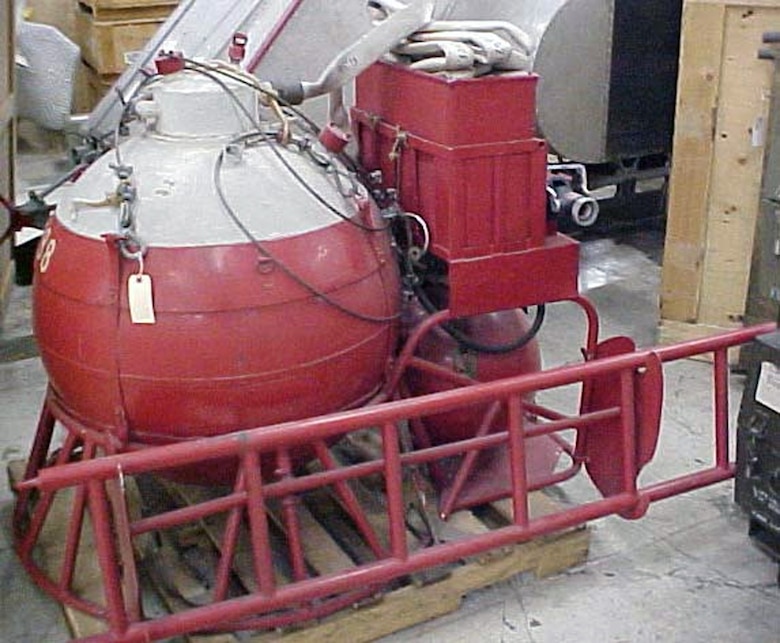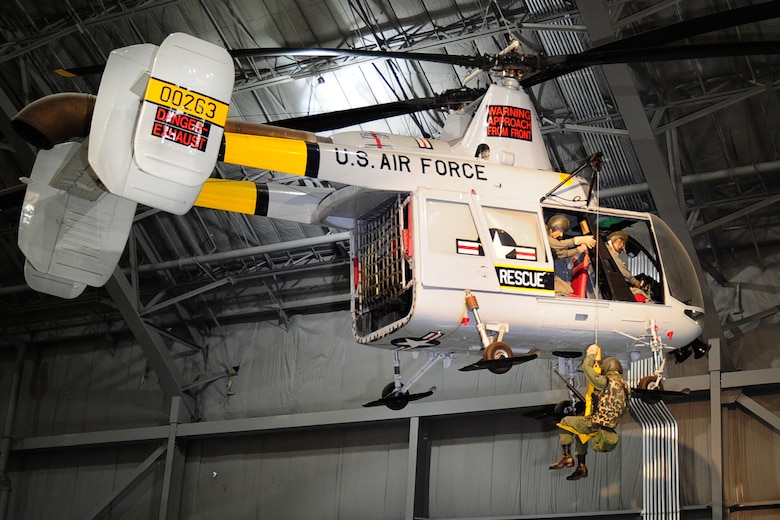
Kaman HH-43B Huskie
The U.S. Air Force acquired the HH-43 Huskie primarily for local base rescue (LBR) and fighting aircraft fires. Kaman delivered the first USAF H-43As in November 1958, and the B series followed in June 1959. In 1962 the USAF changed the H-43 designation to HH-43 to reflect the aircraft's rescue role. The final USAF version was the HH-43F with engine modifications for improved performance.
The Huskie's interesting intermeshing rotor configuration used two wooden rotors turning in opposite directions, eliminating the need for a tail rotor. Large tabs on the trailing edge of each blade warped the rotors and caused the helicopter to rise or descend.
A Huskie on rescue alert could be airborne in approximately one minute with a fire suppression kit hanging beneath. Developed at Wright-Patterson AFB, Ohio, the fire suppression kit weighed only 1,000 pounds, but it could produce almost 700 gallons of fire-fighting foam. Huskies often reached crash sites before ground vehicles arrived, and the foam from the kit plus the powerful downwash of air from the rotors opened a path for rescuers to reach trapped crash victims.
During the Southeast Asia War, the Air Rescue Service (later the Aerospace Rescue and Recovery Service) first used HH-43 Huskies, which became known unofficially as "Pedros" from their radio call sign. First assigned to Da Nang and Bien Hoa Air Bases in the Republic of South Vietnam and to Nakon Phanom Royal Thai Air Base in 1964, the HH-43 remained the only dedicated USAF rescue helicopter until the arrival of the HH-3 Jolly Greens in late 1965.
Flying the first USAF rescue helicopter to arrive in Southeast Asia and the last to leave, HH-43 aircrews saved more lives in combat than crews flying any other USAF helicopter. From 1966 to 1970, they performed a total of 888 combat saves -- 343 aircrew rescues and 545 non-aircrew rescues. It was an HH-43 that carried Airman 1st Class William J. Pitsenbarger on his Medal of Honor mission on April 11, 1966.
The HH-43B on display (serial number 60-0263) established seven world records in 1961-1962 for helicopters in its class for rate of climb, altitude, and distance traveled. It was assigned to rescue duty with Detachment 3, 42nd Aerospace Rescue and Recovery Squadron, Kirtland AFB, N.M., prior to its retirement and flight to the museum in April 1973.
TECHNICAL NOTES:
Armament: None
Crew: Local Base Rescue (LBR)/Firefighting -- Six: Pilot, Copilot, Flight Engineer/Crew Chief, Aeromedical Technician and two Airborne Rescuemen/Firefighters; Aircrew Recovery (ACR) -- Four: Pilot, Copilot, Pararescue Jumper (PJ) and Flight Mechanic/Engineer
Engines: Lycoming T-53 of 860 hp
Maximum speed: 120 mph
Range: 185 miles
Ceiling: 25,000 feet
Rotor diameter: 47 feet
Overall Length: 47 feet

Fire Suppression Kit
This 1,000-pound kit was developed at Wright-Patterson Air Force Base, Ohio, to provide quick aid in fighting aircraft crash fires. The tank contained 83 gallons of water and foam, but when this mixture reached the air at the nozzle, it expanded to more than eight times its volume to produce about 690 gallons of fire-fighting foam. The kit could be picked up from its trailer in a cargo sling by an HH-43 crash-rescue helicopter and lifted to the fire site. A heater was mounted on the trailer to prevent the tank contents from freezing when on "ready alert" status at an airbase in cold weather.
This particular kit is one of two such units assigned to Detachment 6 of the 44th Aerospace Rescue and Recovery Squadron, Andrews Air Force Base, Md., from April 1962 to March 1973. In addition to their use in responding to declared airborne aircraft emergencies, these two kits were carried by HH-43 helicopters providing airborne precautionary protection for Presidents John Kennedy, Lyndon Johnson and Richard Nixon on all helicopter flights between the White House and Andrews Air Force Base and on Air Force One presidential aircraft flights into and out of Andrews.

DAYTON, Ohio -- Kaman HH-43B Huskie in the Southeast Asia War Gallery at the National Museum of the United States Air Force. (U.S. Air Force photo)